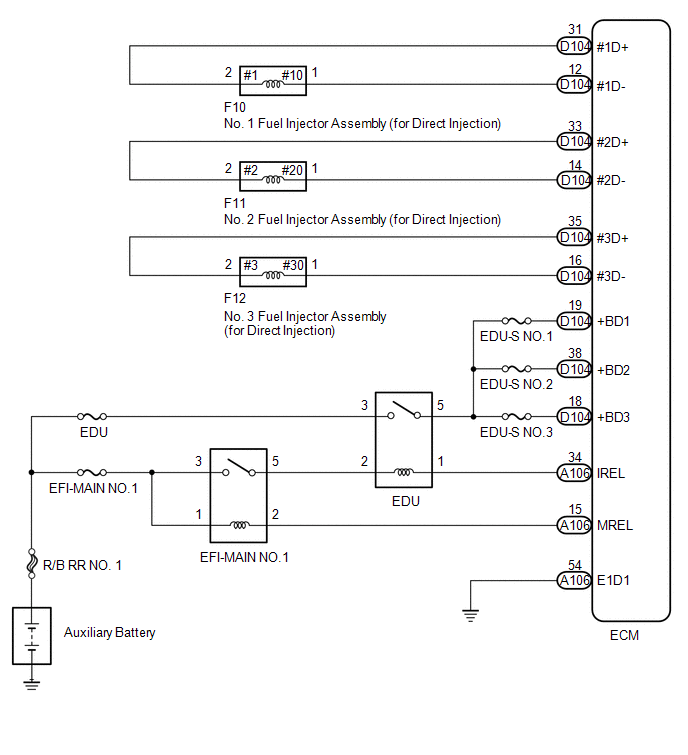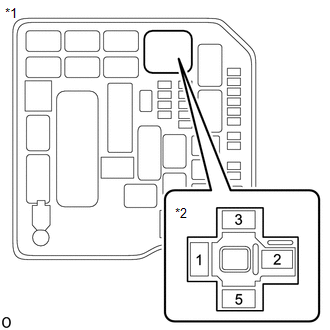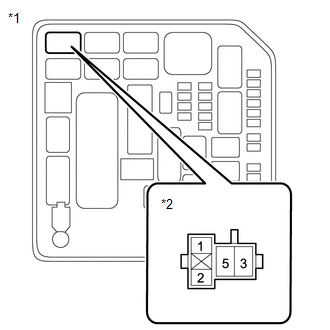Toyota Yaris: Sfi System / Cylinder 1 Injector "A" Circuit Open (P020113-P020313,P062D13)
DESCRIPTION
The D-4S system has two fuel injection systems. One is an in-cylinder direct injection system that directly injects pressurized fuel into the combustion chamber. The other is an intake port injection system. The ECM determines which fuel injection system to use in accordance with the engine conditions. The direct injection system uses an injector driver (EDU) built into the ECM to rapidly operate the direct fuel injector assemblies. It converts injection request signals from the ECM to high-voltage and high-current injector-drive signals that drive the direct fuel injector assemblies.
| DTC No. | Detection Item | DTC Detection Condition | Trouble Area | MIL | Note |
|---|---|---|---|---|---|
| P020113 | Cylinder 1 Injector "A" Circuit Open | Either of following conditions is met (1 trip detection logic):
|
| Comes on | SAE: P0201 |
| P020213 | Cylinder 2 Injector "A" Circuit Open | Either of following conditions is met (1 trip detection logic):
|
| Comes on | SAE: P0202 |
| P020313 | Cylinder 3 Injector "A" Circuit Open | Either of following conditions is met (1 trip detection logic):
|
| Comes on | SAE: P0203 |
| P062D13 | Fuel Injector Driver Circuit Performance Bank 1 Circuit Open | Open or short in direct fuel injector assembly (all cylinders) circuits for 60 times or more (1 trip detection logic). |
| Comes on | SAE: P062D |
MONITOR DESCRIPTION
The fuel injection sequence occurs in numerical order from No. 1 to No. 3.
The ECM monitors the Injector Driver (EDU) at all times. If drivers or direct fuel injector assembly is malfunctioning, the EDU sends direct fuel injector assembly operation condition signals (fail signals) to the ECM. When the ECM receives the signals, the ECM stops the fuel injection control of the appropriate cylinders, cuts voltage to the appropriate EDU relay, and illuminates the MIL.
MONITOR STRATEGY
| Required Sensors/Components (Main) | Direct fuel injector assembly ECM (injector driver) |
| Frequency of Operation | Continuous |
CONFIRMATION DRIVING PATTERN
- Connect the GTS to the DLC3.
- Turn the ignition switch to ON.
- Turn the GTS on.
- Clear the DTCs (even if no DTCs are stored, perform the clear DTC procedure).
- Turn the ignition switch off and wait for at least 30 seconds.
- Start the engine [A].
- Idle the engine for 15 seconds or more [B].
- Turn the GTS on.
- Enter the following menus: Powertrain / Engine / Trouble Codes [C].
-
Read pending DTCs.
HINT:
- If a pending DTC is output, the system is malfunctioning.
- If a pending DTC is not output, perform the following procedure.
- Enter the following menus: Powertrain / Engine / Utility / All Readiness.
- Input the DTC: P020113, P020213, P020313 or P062D13
-
Check the DTC judgment result.
GTS Display
Description
NORMAL
- DTC judgment completed
- System normal
ABNORMAL
- DTC judgment completed
- System abnormal
INCOMPLETE
- DTC judgment not completed
- Perform driving pattern after confirming DTC enabling conditions
HINT:
- If the judgment result is NORMAL, the system is normal.
- If the judgment result is ABNORMAL, the system has a malfunction.
- If the judgment result is INCOMPLETE, perform steps [B] through [C] again.
WIRING DIAGRAM

CAUTION / NOTICE / HINT
NOTICE:
Inspect the fuses for circuits related to this system before performing the following procedure.
HINT:
- If the current from the EDU relay is cut because DTC P062D13 is stored, DTC P123513 will be stored even if the fuel pump assembly (for high pressure side) is normal.
- Read Freeze Frame Data using the GTS. The ECM records vehicle and driving condition information as Freeze Frame Data the moment a DTC is stored. When troubleshooting, Freeze Frame Data can help determine if the vehicle was moving or stationary, if the engine was warmed up or not, if the air fuel ratio was lean or rich, and other data from the time the malfunction occurred.
PROCEDURE
| 1. | CHECK DTC OUTPUT (DTC P020113, P020213, P020313 AND/OR P062D13) |
(a) Enter the following menus.
(b) Read the DTCs.
Powertrain > Engine > Trouble Codes| Result | Proceed to |
|---|---|
| P020113, P020213, P020313 and/or P062D13 is output | A |
| 3 or more of the following DTCs are output: P020113, P020213, P020313 and/or P062D13 | B |
| P062D13 is output |
| B |
 | GO TO STEP 4 |
|
| 2. | CHECK HARNESS AND CONNECTOR |
(a) Disconnect the ECM connector.
(b) Measure the resistance according to the value(s) in the table below.
Standard Resistance:
| Tester Connection | Condition | Specified Condition |
|---|---|---|
| D104-31(#1D+) - D104-12(#1D-) | 20°C (68°F) | 1.34 to 1.64 Ω |
| D104-33(#2D+) - D104-14(#2D-) | 20°C (68°F) | 1.34 to 1.64 Ω |
| D104-35(#3D+) - D104-16(#3D-) | 20°C (68°F) | 1.34 to 1.64 Ω |
| D104-31(#1D+) or D104-12(#1D-) - Body ground and other terminals | Always | 1 MΩ or higher |
| D104-33(#2D+) or D104-14(#2D-) - Body ground and other terminals | Always | 1 MΩ or higher |
| D104-35(#3D+) or D104-16(#3D-) - Body ground and other terminals | Always | 1 MΩ or higher |
HINT:
The standard values shown are direct fuel injector assembly resistance values.
| OK |
 | REPLACE ECM |
|
| 3. | INSPECT DIRECT FUEL INJECTOR ASSEMBLY (RESISTANCE) |
(a) Check the resistance of the direct fuel injector assembly.
Click here

HINT:
Perform "Inspection After Repair" after replacing the direct fuel injector assembly.
Click here

| OK |
 | REPAIR OR REPLACE HARNESS OR CONNECTOR (DIRECT FUEL INJECTOR ASSEMBLY - ECM) |
| NG |
 | REPLACE DIRECT FUEL INJECTOR ASSEMBLY |
| 4. | INSPECT EDU RELAY |
Click here

| NG |
 | REPLACE EDU RELAY |
|
| 5. | CHECK TERMINAL VOLTAGE (POWER SOURCE OF EDU RELAY) |
| (a) Remove the EDU relay from the No. 1 engine room relay block assembly. |
|
(b) Measure the voltage according to the value(s) in the table below.
Standard Voltage:
| Tester Connection | Condition | Specified Condition |
|---|---|---|
| 3(EDU relay) - Body ground | Always | 11 to 14 V |
| NG |
 | REPAIR OR REPLACE HARNESS OR CONNECTOR (AUXILIARY BATTERY - EDU RELAY) |
|
| 6. | CHECK TERMINAL VOLTAGE (POWER SOURCE OF EDU RELAY) |
| (a) Remove the EDU relay from the No. 1 engine room relay block assembly. |
|
(b) Turn the ignition switch to ON.
(c) Measure the voltage according to the value(s) in the table below.
Standard Voltage:
| Tester Connection | Condition | Specified Condition |
|---|---|---|
| 2(EDU relay) - Body ground | Ignition switch ON | 11 to 14 V |
| NG |
 | GO TO STEP 8 |
|
| 7. | CHECK HARNESS AND CONNECTOR (EDU RELAY - ECM) |
(a) Remove the EDU relay from the No. 1 engine room relay block assembly.
(b) Disconnect the ECM connector.
(c) Measure the resistance according to the value(s) in the table below.
Standard Resistance:
| Tester Connection | Condition | Specified Condition |
|---|---|---|
| 5(EDU relay) - D104-19(+BD1) | Always | Below 1 Ω |
| 5(EDU relay) - D104-38(+BD2) | Always | Below 1 Ω |
| 5(EDU relay) - D104-18(+BD3) | Always | Below 1 Ω |
| 1(EDU relay) - A106-34(IREL) | Always | Below 1 Ω |
| 5(EDU relay), D104-19(+BD1), D104-38(+BD2) or D104-18(+BD3) - Body ground and other terminals | Always | 10 kΩ or higher |
| 1(EDU relay) or A106-34(IREL) - Body ground and other terminals | Always | 10 kΩ or higher |
| OK |
 | REPLACE ECM |
| NG |
 | REPAIR OR REPLACE HARNESS OR CONNECTOR |
| 8. | CHECK HARNESS AND CONNECTOR (EFI-MAIN NO. 1 RELAY - EDU RELAY) |
(a) Remove the EFI-MAIN NO. 1 relay, EFI-MAIN NO. 3 relay and EDU relay from the No. 1 engine room relay block assembly.
HINT:
Remove the EFI-MAIN NO. 3 relay and EDU relay connected between the checked terminals as the coil inside the relay influences the measurement value.
(b) Measure the resistance according to the value(s) in the table below.
Standard Resistance:
| Tester Connection | Condition | Specified Condition |
|---|---|---|
| 5(EFI-MAIN NO. 1 relay) - 2(EDU relay) | Always | Below 1 Ω |
| 5(EFI-MAIN NO. 1 relay) or 2(EDU relay) - Body ground and other terminals | Always | 10 kΩ or higher |
| NG |
 | REPAIR OR REPLACE HARNESS OR CONNECTOR |
|
| 9. | INSPECT EFI-MAIN NO. 1 RELAY |
Click here

| NG |
 | REPLACE EFI-MAIN NO. 1 RELAY |
|
| 10. | CHECK TERMINAL VOLTAGE (POWER SOURCE OF EFI-MAIN NO. 1 RELAY) |
| (a) Remove the EFI-MAIN NO. 1 relay from the No. 1 engine room relay block assembly. |
|
(b) Measure the voltage according to the value(s) in the table below.
Standard Voltage:
| Tester Connection | Condition | Specified Condition |
|---|---|---|
| 3(EFI-MAIN NO. 1 relay) - Body ground | Always | 11 to 14 V |
| 1(EFI-MAIN NO. 1 relay) - Body ground | Always | 11 to 14 V |
| NG |
 | REPAIR OR REPLACE HARNESS OR CONNECTOR (AUXILIARY BATTERY - EFI-MAIN NO. 1 RELAY) |
|
| 11. | CHECK HARNESS AND CONNECTOR (EFI-MAIN NO. 1 RELAY - BODY GROUND) |
(a) Remove the EFI-MAIN NO. 1 relay from the No. 1 engine room relay block assembly.
(b) Disconnect the ECM connector.
(c) Measure the resistance according to the value(s) in the table below.
Standard Resistance:
| Tester Connection | Condition | Specified Condition |
|---|---|---|
| 2(EFI-MAIN NO. 1 relay) - A106-15 (MREL) | Always | Below 1 Ω |
| OK |
 | REPLACE ECM |
| NG |
 | REPAIR OR REPLACE HARNESS OR CONNECTOR |
 Engine Oil Temperature Sensor Circuit Short to Ground (P019511)
Engine Oil Temperature Sensor Circuit Short to Ground (P019511)
DESCRIPTION
The engine oil temperature sensor (engine oil pressure and temperature sensor) replaces the oil temperature with electrical signals and outputs them to the ECM...
 Throttle/Pedal Position Sensor/Switch "B" Circuit Short to Ground (P022011)
Throttle/Pedal Position Sensor/Switch "B" Circuit Short to Ground (P022011)
DESCRIPTION Refer to DTC P012011. Click here
DTC No. Detection Item DTC Detection Condition Trouble Area MIL Note P022011 Throttle/Pedal Position Sensor/Switch "B" Circuit Short to Ground The output voltage of VTA2 is below 2...
Other information:
Toyota Yaris XP210 (2020-2025) Reapir and Service Manual: Instrument Panel Illumination does not Turn On
DESCRIPTION The power distribution box assembly controls the instrument panel illuminations. WIRING DIAGRAM CAUTION / NOTICE / HINT NOTICE: Inspect the fuses for circuits related to this system before performing the following procedure. Before replacing the main body ECU (multiplex network body ECU), refer to Registration...
Toyota Yaris XP210 (2020-2025) Reapir and Service Manual: Inspection
INSPECTION PROCEDURE 1. INSPECT FUEL INJECTOR ASSEMBLY NOTICE: This inspection is for checking the fuel injector assembly for an open or short. Because the fuel injector assembly of this vehicle is a high-pressure type, fuel injection volume cannot be checked...
Categories
- Manuals Home
- Toyota Yaris Owners Manual
- Toyota Yaris Service Manual
- Engine Start Function When Key Battery is Dead
- Auto Lock/Unlock Function
- Maintenance
- New on site
- Most important about car
Break-In Period
No special break-in is necessary, but a few precautions in the first 600 miles (1,000 km) may add to the performance, economy, and life of the vehicle.
Do not race the engine. Do not maintain one constant speed, either slow or fast, for a long period of time. Do not drive constantly at full-throttle or high engine rpm for extended periods of time. Avoid unnecessary hard stops. Avoid full-throttle starts.










